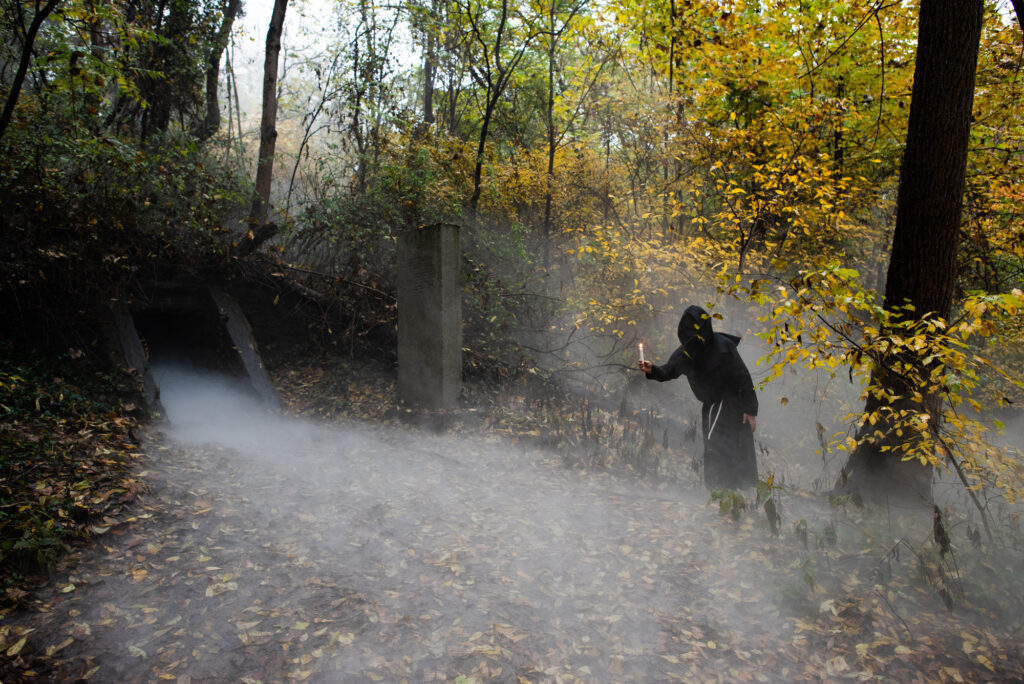
It’s Halloween, a normally festive holiday that’s been made even scarier by the pandemic. Lots of Halloween events have sadly been canceled this year out of care and caution; one of those was typically set in a very special place in Roxborough:
The Hermit’s Cave along the Wissahickon. Which amazingly was created by a Philadelphian who immigrated here from– you can’t make this stuff up– Transylvania.
You may have heard of the legend that a hermit lived in a cave along the Wissahickon for some time. While much of the truth has been lost and the legend has been greatly embellished, Halloween is a great time to dig up the skeleton of the story. And our tale is told by Kris Soffa, longtime Roxborough resident and Trail Ambassador for Friends of the Wissahickon who typically did a spooky night at the cave, which we’ll get to in a moment.
Johannes Kelpius, as Kris explained, “was the son of a Lutheran minister, born in 1667,” she said, yes, in Transylvania. “He was a scholar, writer, alchemist, philosopher, mystic, musician, and scientist,” she continued, “and part of the Pietist movement, breaking off from Lutheranism during the Reformation. He was the leader of a hotbed of people studying the Book of Revelation.” The group decided through their intense study that the world would end in 1694. Inspired by a passage in the book noting the importance of the “Woman in the Wilderness,” which to them signaled they should await the end in the wilds of the New World. As Philadelphia was close to the 40th parallel, and 40 was mystical to the group, and the city was tolerant of religious freedom, they came to Philadelphia, bringing 40 men to start their celibate cult in the New World wilderness to await the end. As Kelpius went to college in Germany, much of his group were highly literate German men, and they found a German patron to buy them land, not far from Germantown, again finding people sympathetic to their story.
It was America’s first Doomsday Cult. They set up shop off now-named Hermit Lane at the bottom of Roxborough near the Wissahickon, erecting a tabernacle 40 feet wide by 40 feet long, the 40 men living (near the 40th parallel, remember) in huts nearby. Legend says Kelpius himself lives in a cave here; some legends even say the group lives in caves along the creek, but there are not many true caves here– it’s the wrong kind of rock.
And while (spoiler alert!) the world does not end in 1694, the group stays busy. Learned men in a small growing town– Philadelphia has only 500 buildings when they arrive– “they become successful doctors and lawyers,” continued Kris, “so they are visiting Germantown, people coming to them for healing.” They grow a large botanical garden that includes many of the plants they need for their medical work. Kris says the group sets up the first observatory in the New World, at Lover’s Leap in the Wissahickon, using instruments Kelpius brought with him. He wrote the first piece of music in the New World, a book of hymns, some still used today. His follower Christopher Witt, a Brit expatriate, painted his portrait, the first oil painting in the New World. Wikipedia adds that Witt also “built them a pipe organ… the first privately owned organ in North America.”
As 1694 passes without the world ending, some of the followers become disenchanted, and the group struggles. Kelpius dies in 1708, many blaming his ascetic life in a cave for his death in his 40s. The effort ends with the land being purchased by the well-established Righter family who operated a shad fishery, mills, and ferry along the Schuylkill.
In 1848, the Righters sold the site of the tabernacle and one “hermit” cabin to the son of a Russian count, who built a country house here he named the Hermitage. Evan’s son sold the property in 1895 to Fairmount Park for $1.
The cave is downhill of the Hermitage off Hermit Lane. Carefully lined with rock and lintels, it appears more like a root cellar. While several websites claim it was a springhouse, no spring emerges from its solid-stone floor. Kris doubts this was ever a hermit’s cave, but where Kelpius really lived and whether it was a hut or a cave has been lost in time. That said, the Rosicrucians, another sect that has claimed Kelpius, erected a stone marker to him here in 1961– which stands today.
In recent years, Kris Soffa orchestrated a special evening event there. A prop coffin was wheeled into the cave, as she described, “and spooky re-enactors in full Halloween regalia lit candles and incense and laid out artifacts which Kelpius might have used, like an astrolabe, crystals, and alchemy objects. The hermit himself, in Renaissance robes and hood, waited inside the cave at a small table and chair.” As her group walked to the cave, costumed characters joined them as escorts, and at the cave, a vampire of course emerged from the coffin, a joyful mashup of history and Hallwoeen.
But not to be done this year! Stay tuned for next year, and in the meantime, Happy Halloween.
By Mike Weilbacher. Executive Director. Mike tweets @SCEEMike, and can be reached at [email protected].
